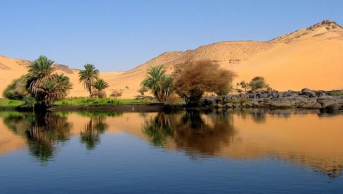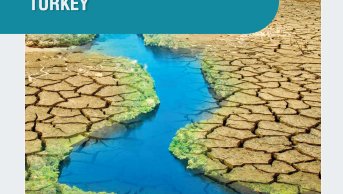‘Hydraulic Mission’ the Middle East: The Turkish Case

Although dam-building is nearly as old as the humanity, it witnessed a rapid rise after the Industrial Revolution. In the second half of the 19th century, with the appropriate machinery and lots of available energy, it became technically feasible to build large structures like dams of today. The role of dams in economic development is well-established. From the economic perspective, benefits of dams are outstanding. They provide reliable supply of water for all people and economic sectors, they provide energy, they regulate flows and thus prevent economic losses from droughts and floods. In other words, many benefits of water resources became easily accessible thanks to dams. Thus, dams, became to be seen as monuments of development in the 20th century.
This happened first in the global North, under the term of ‘hydraulic mission’. ‘From the 1930s to the 1970s, the construction of large dams became – in the eyes of many –synonymous with development and economic progress. Viewed as symbols of modernization and humanity’s ability to harness nature, dam construction accelerated dramatically. This trend peaked in the 1970s, when on average two or three large dams were commissioned each day somewhere in the world.’ The Middle East was not an exception. Damming histories of Egypt, Syria, Iraq, Iran and Turkey exemplify the continuation of hydraulic mission despite changing socio-economic dynamics in these countries. A closer look to the case of Turkey might illustrate better.
Turkey’s strong emphasis on dam-building as its main way dealing with water challenges has remained unchanged despite structural changes in its socio-economic dynamics. It would, thus, still be plausible to state that the center of water management in Turkey is dams. It has been argued by the Hydraulic Works of Turkey that ‘owing to considerable variation observed in the run-off in terms of seasons, years and regions, it is absolutely necessary to have water storage on the rivers in Turkey. This ensures access to water when it is necessary. Construction of the dams in Turkey is not only for irrigation and hydropower production, but also for the long term domestic water supply. Consequently, Turkey has prioritized the construction of water storage facilities.’
Why is the hydraulic mission so powerful? Because of –at least- three main reasons:1- market-related, institutional, financial, and even intellectual barriers. Adopting alternatives is much more difficult than it may seem. 2- There are established incentive mechanisms that promote conventional water-supply solutions, particularly dams. Some of these incentives are so subtle. 3- For many governments worldwide, it seems easier to demonstrate big infrastructure investments as achievements. Incremental and somewhat patchy improvements are generally difficult to appeal constituents’ support.
In a more or less successive fashion, three priorities or themes have driven Turkish damming discourse. These are i) agriculture, ii) energy, and iii) scarcity.
Turkish economy largely remained an agrarian one until 1980s. According to the World Bank statistics, the share of agriculture in Turkey’s economy was around 56 % in 1960. However, most of the agricultural lands were not irrigated. The possibility of irrigation was promising immense increases in yields, thus, incomes in the large agricultural population. Therefore, expansion of irrigation schemes was seen as a shortcut to development. In this context, like many other developing countries of the era, Turkey embraced dam-building as the main and the best way in combatting rural poverty. So, starting from 1954, important dams like Hirfanlı (Kırşehir-1959), Ayrancı (Karaman-1958), Demirköprü (Manisa-1960), Elmalı-II (İstanbul-1955), Kemer (Aydın-1958), May (Konya-1960), Sarıyar (Ankara-1956), Seyhan (Adana-1956), Sille (Konya-1960), Şabanözü (Çankırı-1960) were completed.
Coming to 1960s and 1970s, the share of agriculture shrank more than 50 %, reaching down to 26.5 by 1980. Also, Turkey completed a great number of big dams with purpose of irrigation. While the salience of agriculture was in decline, Turkey continued to be one of the biggest dam-building countries during 1960s well into 1980s. Between 1960 and 1980 some 111 dams were constructed.
From 1980s onwards, the main pro-dam rhetoric was related with the energy needs of the country. There are several reasons for this. First, the role of agriculture in Turkey’s economy continued to diminish. By 1980, the share of agriculture was 26.5 %. Two decades later, in the year 2000, it further shrinked to 11 %. Also, following the liberalization efforts in early to mid 1980s, Turkey’s economy rapidly began to become an export-oriented economy. To illustrate, the total exports of Turkey was USD 2.91 billion in 1980. By the end of the dace it increased more than four-fold and reached to USD 12.96 billion in 1990. Turkey also experienced an intense urbanization during 1980. The urban population reached from 43% to 60% between 1980 and 1990. The pace of urbanization slowed down a bit in the following decade, reaching to 64 % by 2000. In line with this, Turkish officials started to frame rising energy demands as the top priority behind dam construction. According to Ministry of Foreign Affairs, for instance,‘Turkey’senergyconsumption is risingsignificantlyduetorapidurbanizationandindustrialization. Itshouldalso be emphasizedthatpercapitaenergyconsumption in Turkey is onlyonesixth of that of the EU averageandincrease in theenergyconsumptionmeansimprovingthequality of life of theTurkishcitizens. Turkey, which is neitheroilnornaturalgasproducer, planstomeettherisingenergyneed in severalways, includingtheincreasinguse of itsindigenoussourcesand in thatrespect, hydropower’.
It became, thus, an imperative for Turkish authorities to satiate the needs of the energy-thirsty manufacturing industries. In addition to this, throughout 1980s, the tourism industry began to enjoy substantial support from Özal governments and soon became one of the biggest energy using sectors in economic life.
Starting from mid-1980s, i.e. during the rise of neoliberal developmental state, the discursive focus shifted towards the scarcity rhetoric. One of the reasons behind the rise of ‘scarcity logic’ (and concomitant fall of the ‘energy logic’) is associated with the fact that Turkey has finished many big hydro-dams, in late 1980s and early 1990s. By mid-1990s for instance, most of the 19 hydroelectrical plants within the GAP framework was completed. On the other hand, the expanding use of natural gas started to, albeit temporarily, ease Turkey’s energy needs from 1990s onwards. Also, the introduction of the Falkenmark Index in 1989 reinforced the idea that water augmentation through dams is a must for a country like Turkey. Because, according to MFA, ‘Turkey is situated in a semi-arid region, and has only about one fifth of the water available per capita in water rich regions such as North America and Western Europe’. Starting from 1990s, numerous authorities, like State Hydraulic Works, started to underline the argument that ‘Turkey is not a “water-rich” country as it is often presumed. To the contrary, the country is vulnerable to facing water shortage problems in near future unless necessary interventions are made’. DSI further states, ‘per capita water usable is 1,600 m3. Looking at some other countries and the world average, it is seen that Turkey is among those facing water shortage in term of per capita usable water endowment. Today, it is accepted that a country should have annual per capita water potential of more than 5,000 m3 in for being classified as “water rich.” Population of Turkey is expected to be 100 million in 2023. Then it is possible to conclude that per capita water potential in Turkey will further fall to 1,125 m3 by that year.’ Between 1980 and 2000, 385 dams were completed in Turkey. 151 of them have capacities greater than 1 bcm. Between 2000 and 2015 (the most recent year with data), 120 dams were completed. Among these, however, only 12 of them has capacities bigger than 1 bcm.
In short, the Middle East, as part of the greater Global South, still adheres to the hydraulic mission. As of late 2010s, there is no widespread utilization of non-dam solutions of water supply. As Turkish case demonstrates, hydraulic mission continues to remain a viable policy option despite significant transformations in socio-economic structures of a given country.









